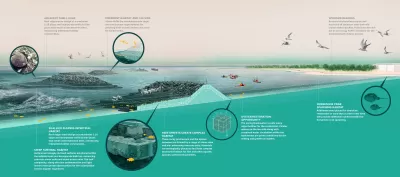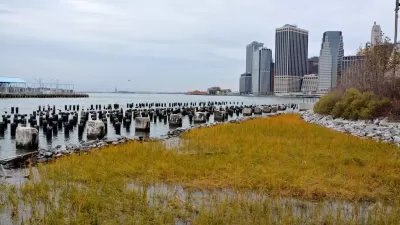The coastal resiliency and biodiversity project is taking shape in Raritan Bay, an area devastated by Hurricane Sandy in 2012.

New York State has broken ground on a $107 million coastal resiliency project called Living Breakwaters, reports Matt Hickman. "Alongside swaths of Lower Manhattan and low-lying waterfront communities in Brooklyn and Queens such as Red Hook, the Rockaways, and Howard Beach, Staten Island’s Tottenville neighborhood on the far southern end of the borough suffered some of the most significant damage within New York City during [Hurricane Sandy]."
Designed by landscape architecture and urban design studio SCAPE, Living Breakwaters "will take the form of a series of near-shore breakwaters built from stone and “ecologically enhanced concrete units” that will break waves and reduce beach erosion while also providing a new habitat for oysters and other marine life."
The project was selected as the winner of "the U.S. Department of Housing and Urban Development (HUD)’s post-Sandy Rebuild by Design competition," which sought to find innovative ways to reduce flood risk and conserve the shoreline. "As detailed in a press release, in addition to providing Tottenville with an additional layer of robust protection against climate change-exacerbated storms, Living Breakwaters, a major work of natural infrastructure informed by “hydrodynamic modeling, iterative testing, environmental review, and extensive public engagement,” will feature “reef ridges” and “reef streets” meant to foster marine biodiversity."
The project is scheduled for completion in 2024.
FULL STORY: SCAPE’s Living Breakwaters project begins in-water construction off of Staten Island

Alabama: Trump Terminates Settlements for Black Communities Harmed By Raw Sewage
Trump deemed the landmark civil rights agreement “illegal DEI and environmental justice policy.”

Planetizen Federal Action Tracker
A weekly monitor of how Trump’s orders and actions are impacting planners and planning in America.

Why Should We Subsidize Public Transportation?
Many public transit agencies face financial stress due to rising costs, declining fare revenue, and declining subsidies. Transit advocates must provide a strong business case for increasing public transit funding.

Understanding Road Diets
An explainer from Momentum highlights the advantages of reducing vehicle lanes in favor of more bike, transit, and pedestrian infrastructure.

New California Law Regulates Warehouse Pollution
A new law tightens building and emissions regulations for large distribution warehouses to mitigate air pollution and traffic in surrounding communities.

Phoenix Announces Opening Date for Light Rail Extension
The South Central extension will connect South Phoenix to downtown and other major hubs starting on June 7.
Urban Design for Planners 1: Software Tools
This six-course series explores essential urban design concepts using open source software and equips planners with the tools they need to participate fully in the urban design process.
Planning for Universal Design
Learn the tools for implementing Universal Design in planning regulations.
Caltrans
Smith Gee Studio
Institute for Housing and Urban Development Studies (IHS)
City of Grandview
Harvard GSD Executive Education
Toledo-Lucas County Plan Commissions
Salt Lake City
NYU Wagner Graduate School of Public Service




























